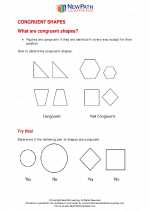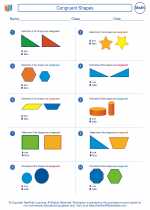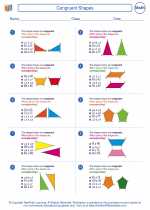Rotation
Rotation in mathematics refers to the movement of a figure around a fixed point. The fixed point is called the center of rotation. When a figure is rotated, its size and shape remain the same, but its position changes.
Key Concepts
- Center of Rotation: The fixed point around which the figure is rotated.
- Angle of Rotation: The amount of rotation, measured in degrees, from the original position to the final position of the figure.
- Direction of Rotation: Clockwise or counterclockwise rotation, determined by the direction in which the figure moves around the center of rotation.
Types of Rotations
There are two main types of rotations:
- Clockwise Rotation: The figure moves in the direction of a clock's hands.
- Counterclockwise Rotation: The figure moves in the opposite direction to a clock's hands.
Rotation Notation
Rotations can be described using notation. For example, a 90-degree counterclockwise rotation of a figure F around point P can be denoted as "RP,90°(F)".
Properties of Rotations
Some important properties of rotations include:
- Rotating a figure multiple times around the same center results in cumulative rotations.
- Rotating a figure 180 degrees results in its reflection over the center of rotation.
Study Guide
When studying rotations, it is important to practice the following:
- Identifying the center of rotation in a given figure.
- Determining the angle and direction of rotation required to move a figure to a specific position.
- Understanding the effects of multiple rotations on a figure.
- Using rotation notation to describe and perform rotations.
◂Math Worksheets and Study Guides Fifth Grade. Congruent Shapes
Study Guide Congruent Shapes
Congruent Shapes  Worksheet/Answer key
Worksheet/Answer key Congruent Shapes
Congruent Shapes  Worksheet/Answer key
Worksheet/Answer key Congruent Shapes
Congruent Shapes  Worksheet/Answer key
Worksheet/Answer key Congruent Shapes
Congruent Shapes 

 Worksheet/Answer key
Worksheet/Answer key
 Worksheet/Answer key
Worksheet/Answer key
 Worksheet/Answer key
Worksheet/Answer key

The resources above cover the following skills:
Geometry (NCTM)
Analyze characteristics and properties of two- and three-dimensional geometric shapes and develop mathematical arguments about geometric relationships.
Identify, compare, and analyze attributes of two- and three-dimensional shapes and develop vocabulary to describe the attributes.
Explore congruence and similarity.